A pear-shaped variety with a sweet taste and amazing aroma - the Ivan Kupala tomato
The interesting name of the tomato Ivan Kupala undoubtedly attracts the attention of many gardeners. An association immediately arises with an ancient Russian holiday, custom, and traditions that have been preserved to this day.
The variety has established itself as a crop that is unpretentious in care, can take root in any region, is disease-resistant and has a good fruiting rate. Vegetables of this type are unique with their unusual appearance and unique taste, which has absorbed all the sweetness of summer. Such tomatoes on the table are a holiday for everyone, as evidenced by the name of this vegetable crop.
Characteristics and description of the variety
The originator of the variety is the agricultural company “Siberian Garden”.
Bush indeterminate, 1.5-1.6 m high, heavily leafy. The leaves are slightly elongated, with smooth edges. The variety is mid-season, carpal. One brush bears up to 7 fruits.
Productivity is average. 2-3 kg of vegetables are harvested from 1 bush, provided that 3-4 seedlings are planted per 1 square meter. m. Endowed with innate immunity to the main diseases of the nightshade family.
Culture needs obligatory stepsoning and tying up tall bushes.
Reference. Stepchildren are lateral processes on the stem growing from the axil of the leaf. Stepsoning a plant is called removing the stepsons. Pruning is carried out so that nutrients are spent on the formation and ripening of high-quality fruits, and not on the growth of unnecessary shoots.
Ivan Kupala is recommended for cultivation in open ground and in greenhouse conditions.
The fruits have an uncharacteristic shape for a tomato, resembling a pear in appearance., the average weight of one is 150-200 g. The color is red-raspberry, the taste is excellent, sweet, without a feeling of sourness. The skin is thin but dense, so the fruits do not crack. The pulp is juicy and fleshy.
The purpose of tomatoes is universal: they are suitable for pickling, marinades and canning. They are also used for processing to make tomato products: paste, ketchup, juice. But the most important purpose is fresh consumption. Tomatoes are ideal for summer salads, vegetable dishes, appetizers and baked meats.
Despite the thick skin, the vegetables cannot withstand long-distance transport, although they are subject to long-term storage.
The photo shows Ivan Kupala tomatoes.
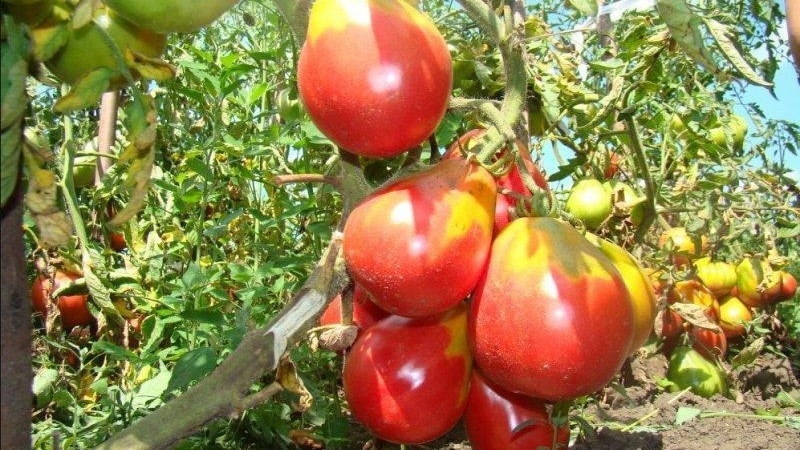
How to grow seedlings
Sowing of seeds begins 60-65 days before planting seedlings in the ground. First, the seeds are checked for germination in a saline solution. To do this, dilute half a teaspoon of salt in 1 glass of water and dip the grains into the solution for 10 minutes. Those that have floated to the surface are not suitable for sowing.
Reference. Tomato seeds remain viable for 5 years. After this period, germination and fruiting are much slower.
Then the seeds are disinfected in a weak solution of potassium permanganate or in a 2% solution of hydrogen peroxide. The grains are placed in gauze and placed in a disinfecting solution. Leave in potassium permanganate for 20-30 minutes, in peroxide for 8 minutes.
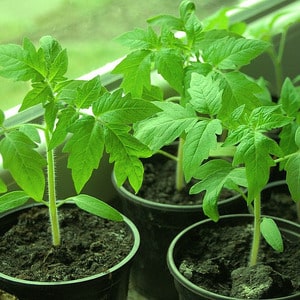 Only sprouted ones are sown in the ground seeds. To do this, they are placed between two pieces of gauze, slightly moistened and left in a warm and dark place at a temperature of 22-25°C. Periodically moisten the gauze to prevent it from drying out.The grains sprout on days 5-7. After germination, they are immediately transferred to a illuminated place - on a windowsill or under artificial lighting lamps.
Only sprouted ones are sown in the ground seeds. To do this, they are placed between two pieces of gauze, slightly moistened and left in a warm and dark place at a temperature of 22-25°C. Periodically moisten the gauze to prevent it from drying out.The grains sprout on days 5-7. After germination, they are immediately transferred to a illuminated place - on a windowsill or under artificial lighting lamps.
The soil is prepared from garden soil, humus and peat and the planting containers are tightly filled with it. Sprouted grains are sown to a depth of 1 cm and covered with a thin layer of earth on top. The containers are moistened with a spray bottle and left in a warm room at a temperature of at least 22°C.
You can plant in a common wooden box or in individual plastic and peat cups. Peat cups have the best indicator of seed germination.
A few days after sowing, the first shoots appear. During this period, the temperature is reduced to 18°C.
Water the soil as the top layer dries out, moderately, without flooding the young shoots, with warm, settled water from a shallow watering can. After watering, the soil is loosened with a wooden stick, superficially, so as not to damage the roots.
Daylight hours for seedlings should be at least 16 hours. If natural light is not enough, add phytolamps.
When 2 true leaves appear, the seedlings are picked and placed in separate containers. If the seeds are sown in individual containers, picking is not carried out.
A week before planting in open ground, seedlings begin to adapt to outdoor conditions using the hardening method. To do this, they are taken out into the open air for 1-2 hours, gradually increasing the interval of stay on the street to 14 hours. At the same time, the night temperature of the room where the seedlings are brought overnight is reduced to 12-14°C.
How to grow tomatoes
After 2 months, the seedlings are ready for planting in open ground. By this time, young bushes reach 30-35 cm in height and have 12-14 true leaves.An important factor when replanting is soil temperature. It should not be lower than 12°C. Otherwise, soil that is not heated to the required temperature will slow down the growth and development of the crop.
Planting pattern: 50 cm – distance between seedlings, 50 cm – between rows. For 1 sq. m place no more than 4 seedlings.
The wells are prepared in advance by adding 1 tablespoon of ash and 0.5 teaspoon of superphosphate to them. The depth of the hole is 15 cm.
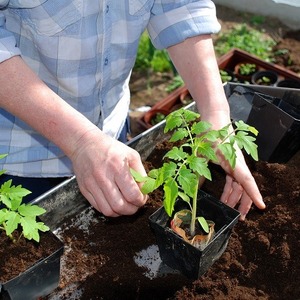 After transplantation, the soil is moistened, loosened and hilled, and within 1 week the young bushes get used to the new place. To retain moisture, the beds are mulched with straw or weeds, which later, when rotting, provide the young plants with the necessary nutrients. In addition, mulching the beds prevents the penetration of pests.
After transplantation, the soil is moistened, loosened and hilled, and within 1 week the young bushes get used to the new place. To retain moisture, the beds are mulched with straw or weeds, which later, when rotting, provide the young plants with the necessary nutrients. In addition, mulching the beds prevents the penetration of pests.
A week later, regular moderate watering. Water strictly at the root, with warm, settled water, no more than 2 times a week. On hot, dry days, the number of waterings is increased to 4. It is important to monitor the condition of the soil and not to over-wet the soil. With high humidity, fungal spores can quickly develop, which will lead to plant disease.
The first feeding is carried out 2 weeks after transplantation. Fertilize with organic matter, for example, chicken droppings, humus or minerals fertilizing. The main thing is to dilute the organic matter well with water to avoid burns to the root system. The optimal ratio is 1:15.
Reference. When using fresh manure as a top dressing, the taste of tomatoes becomes bitter.
The second feeding is carried out during the appearance of flowers, and the third - during fruit set.
Another important stage in crop care is stepsoning. If you do not remove excess shoots, the growth of green mass will lead to the fact that the fruits will not be able to receive the necessary nutrients for further development. Shoots are removed when their length is 4-8 cm. At this stage of growth, the plant experiences the least stress. After removing the stepsons, the bushes are treated with a weak solution of potassium permanganate to reduce the risk of infection.
Reference. The pinching procedure is carried out in the morning so that by the evening all the wounds have time to heal.
The plant is formed into 2 stems. This method leads to the best fruiting rate.
If you are tall, a garter is required. Despite the strong stem, the tall bush will not be able to withstand the fruiting clusters and will break from the weight of the ripe fruits. They tie it up immediately when transplanting seedlings into the ground. A wooden support or metal rods are installed next to each bush and the stem is fixed for its proper further formation. As the branches grow and develop, they are also fixed to the support.
Diseases and pests
The culture has proven itself to be resistant to major diseases of the nightshade family and pest attacks. However, the plant can infect late blight and powdery mildew.
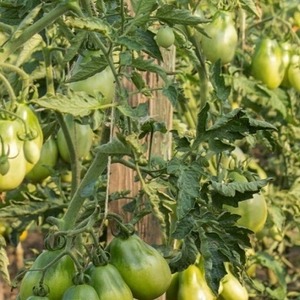 These are fungal diseases, which means that high humidity and air temperature are necessary for their spread. Monitoring the moisture content of the beds is a necessary preventive measure, as is the removal of lower leaves that can rot, thereby helping the development of fungal spores.
These are fungal diseases, which means that high humidity and air temperature are necessary for their spread. Monitoring the moisture content of the beds is a necessary preventive measure, as is the removal of lower leaves that can rot, thereby helping the development of fungal spores.
When affected by late blight, the bushes are treated with systemic fungicides, for example, Fitosporin.
This fungicide is also used to combat powdery mildew.
Mustard powder, which is sprayed on the crop, protects against the Colorado potato beetle, whitefly, aphids and slugs. Mustard bushes planted between tomatoes also repel these pests. You can also spray with a solution of vinegar, the smell of which is smelled by parasitic insects from afar and avoided.
A soap solution used to treat the affected stems helps against aphids. To prepare the solution, dissolve 1 piece of laundry soap in 2 liters of water.
The nuances of growing in a greenhouse and in open ground
The variety is recommended for cultivation in open ground and in protected structures. In the southern regions, where summers are warm and long, tomatoes are grown in open beds. In cold regions with short and cool summers, it is recommended to cover with film.
Greenhouse bushes grow higher, so the crown of the plant is pinched to indicate the growth point.
Closed structures require systematic ventilation. Constant high temperature and humidity contribute to the rapid spread of fungal spores, which leads to disease. A regular supply of fresh air destroys the pathogenic environment of infections and some insect pests living in greenhouse conditions.
Harvesting and application
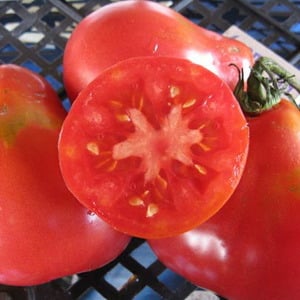 Harvesting begins in early August. The ripening of fruits is not uniform, at different times, but picking ripe vegetables from tied branches is not difficult.
Harvesting begins in early August. The ripening of fruits is not uniform, at different times, but picking ripe vegetables from tied branches is not difficult.
The most important purpose of vegetables is to eat them fresh. They are ideal for summer salads, appetizers, hot and vegetable dishes (stews, purees). Vegetables are high in vitamins and are recommended to boost immunity. Suitable for dietary nutrition.
Small tomatoes are used for canning and pickles, while larger fruits are good in marinades. Vegetables retain their taste in processed tomato products (ketchup, juice, paste, sauces, adjika).
The optimal transportation period is no more than 10 days. This tomato variety does not retain its taste characteristics and presentation during long-term transportation, although it can be stored for a long time.
Advantages and disadvantages of the variety
In addition to its unusual appearance and ideal taste, the Ivan Kupala tomato has many other positive characteristics:
 ease of care;
ease of care;- ability to settle down in any region;
- high resistance to major diseases;
- good fruiting rate;
- the ability to independently select seeds for the next planting;
- excellent taste of vegetables;
- unusual shape;
- contains a large amount of vitamins;
- suitable for dietary nutrition.
Some negative aspects of this type:
- Garter required;
- stepsoning required;
- does not tolerate long transportation.
Farmer reviews
Most opinions indicate the excellent taste of ripe vegetables and simple agricultural technology. Many gardeners are interested in this crop precisely because of its unique external characteristics, since whole-fruit canned vegetables look very unusual.
Some opinions of summer residents:
Angelina, Kislovodsk: “I really liked the tomato. Pleasant taste, excellent pickling. They do not require any care; the harvest is enough for the whole family. Ideal for all lovers of excellent tomatoes.”
Adam, Ryazan region: “I was struck by the unusual shape and color. From the bush, as stated, 2-3 kg of vegetables can be harvested, it is not demanding in care, and no diseases have affected it.I’ll definitely plant more.”
Conclusion
Thanks to its positive qualities, the Ivan Kupala tomato has gained many fans who want to see it in their beds year after year. Unpretentiousness in care, high resistance to many dangerous diseases, fruiting in all regions and high yields - these are the main characteristics that guide not only beginners, but also experienced gardeners when choosing a crop.
The taste of the fruit, which will not leave even the most fastidious gourmet indifferent, is another reason for the final choice of this tomato crop.